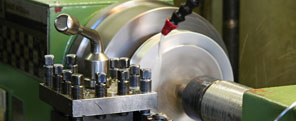Best Practices for Mixing
Water-Based Lubricants
Generally, water-based metalworking fluids are mixed on-site from a metal removal fluid concentrate according to manufacturer recommendations regarding mixing proportions. By following recommended mixing procedures for these fluids and checking the mixing results for the right concentrations, you can minimize any subsequent machining issues relating to water based lubricants.
After mixing and before the machines start running, the fluid should be checked with a refractometer (or, alternatively, a chemical titration method) to determine that the correct starting concentration was achieved.
If you are filling an empty sump, the starting chemical proportions are called the charge mix ratio. Similarly, makeup mix ratio is the term applied to the mixing proportion of fluid to replace fluid lost in operation. The ratio of metalworking fluid concentrate in a makeup mix is typically lower than that in the charge mix.
Mixing Metalworking Fluids from Concentrate
Charge and makeup mixes can be combined with a mechanical mixer (proportioner) or by hand. Mechanical mixing is recommended because it does a better, more uniform job of mixing chemical components.
Here are some general guidelines for mixing lube formulations from concentrate:
- The first rule in mixing metalworking fluids is that you always add fluid concentrate to water -- not the other way around, unless instructed to do so by the manufacturer. Doing it this way ensures that the emulsifiers will properly suspend the oil in water, which is what you want to happen.
- Whether you use an automated proportioning and mixing system or a hand mixing method, the formulation must be thoroughly mixed. If you are mixing manually in a vessel separate from the sump, first fill the vessel half-full of water. Then add concentrate to the water. Then add the remainder of the water to stimulate turbulence and start the mixing process.
- After mixing, check the fluid concentration with a refractometer or chemical titration method to be sure your proportions are correct.
- After years of experience you may think you've developed a "feel" for how the metalworking fluid mixture should look or feel. This may be somewhat true, but it is no basis by which to maintain an accurate fluid concentration.
- Use water cooler than 50°F, if possible.
Makeup Mix Ratios
During the course of a day in operation, a machine tool may deplete its metalworking fluid reservoir by as much as 10 percent through evaporation, consumption in service, hard water reactions or even splashing. When this happens, fluid concentrations have to be adjusted.
If the fluid mix in the machine reservoir is too lean in concentration, it is general practice to add a makeup mix daily. The proportions of this mix vary with the type of fluid, but the makeup mix ratio of concentrate is generally more dilute than the target ratio in the reservoir.
If a fluid is too rich in concentrate, it is not recommended to simply add water. The best practice is to empty a portion of the rich fluid in the reservoir into another drum or holding vessel. This can then be replaced with a leaner solution.
Acculube Can Help
Acculube fluid technicians are ready to help you choose the best lubricant products based on your machinery, throughput and parts. They can also help you formulate and maintain the ratios in your metalworking fluids that will deliver the best performance, and lowest overall cost.
NEXT ESSAY
 |
|
Talk with Us Today
Call the metalworking experts at Acculube - we'll help you get the most value
from every lubricant and other critical fluid you buy, and avoid the common pitfalls that can cost you money.
Contact Us: 1.800.404.2570 or email us at sales@acculube.com
|
|


